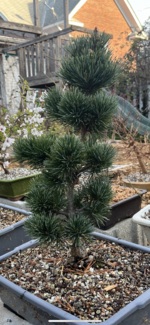I have the BT pines book. I don't think it gives a coherent overview of pines in a helpful non-confusing way. It feels cobbled together from other books/magazines and not really written with a singular mission of telling you how a pine works. I would argue that the book has almost nothing to say about building pines from scratch. Yeah, it tells you how to start a shohin trunk in the famous pine-from-seed chapter, but it actually stops right as things get very involved in the canopy. The chapter on building a cascade is an interesting case study but as a source for techniques, it's flawed and incomplete IMO.
So far I haven't seen anything written about pine techniques in English-language books that is in the same tier as this Japanese black pine manual (if you need a warning before clicking an imgur link, it's the picture of a cover of a japanese black pine book):
. There's a white pine, red pine, and shimpaku edition of this book. That said -- Personally, I've found the books to be a very very minor supplement to mentoring under other pine growers who know what they're doing and having mature pines to look at in person.
What the books don't really teach or convery properly (though the Japanese books at least have gobs and gobs of diagrams and photos about it) is how it all comes together in seasonal practice, how it all assembles in 3D, how you go from thinning to wiring to branch/shoot placement, etc. But you get that on your first day working with a pine nerd.
BTW
@dbonsaiw , the tree in your picture is a white pine, not a black pine (maybe you misspoke), and if it were my tree, the remainder of this decade would be spent thinning out needles to favor budding areas (and making room for wire), then applying wire to branches & pulling those branches down, and perhaps pruning once in a blue moon, but not much initially -- I'd be spending quite a bit of time on fixing the nebari first. The BT pines book makes it sound like candle pinching would be a major part of this process, but I might not need to pinch this until well into the 2030s, given the near-term goals.


